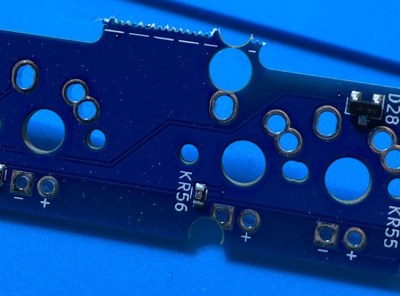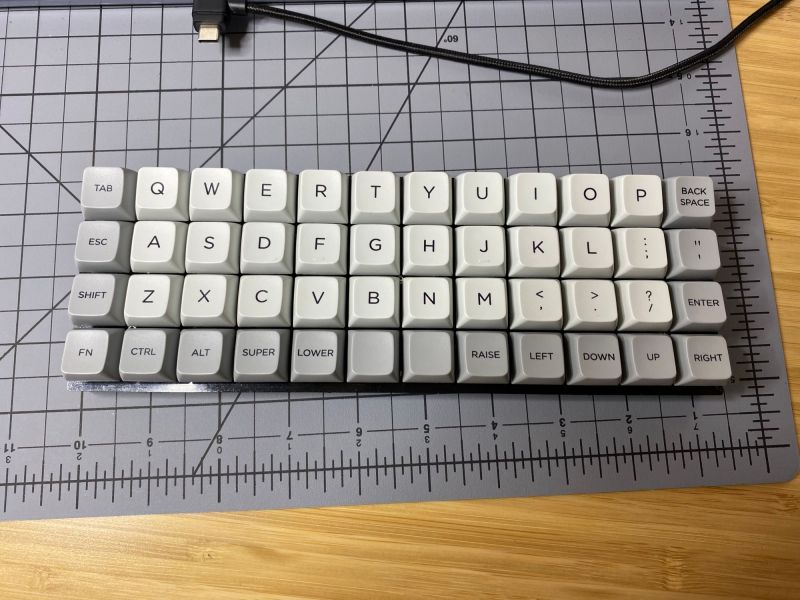Once upon a time, keyboards were something that you took with you from computer to computer, because most of them were built quite nicely. After a few dark decades of membrane keyboards being the norm, the rise of the mechanical keyboard community has shined a light on what is possible with open source designs. Anyone can join in, because quality clackers now exist on every level, whether you want to design the perfect split ortho with OLEDs, rotary encoders, and rear view mirrors, or just want to fork over some money and get to punching switches.

Building your own keyboard doesn’t have to be daunting. It can be as easy or as involved as you want. There’s still a fair amount of soldering simply because it’s a keyboard. But there are plenty of options if you don’t want to do a whole lot beyond soldering switches (or hot swap sockets!) and putting a case together.
Take for instance the JNAO (Just Need An Ortho) build that [Jared] just finished. It starts with a PCB and on-board controller, and the idea is to customize it from there. You’re left to 3D print, laser cut, or otherwise carve your own case and a plate to stabilize the key switches, and then get down to business deciding on switches and keycaps.
The interesting thing about the JNAO is the breakaway row of keys on the bottom. The standard grid is 12×5, but if you don’t need the dedicated number row along the top like [Jared], you’re not stuck with it. And you’re not stuck with the default layout, either. Flashing to a standard Planck layout didn’t go as easily as [Jared] might have liked, but we think he was wise to get the firmware squared away before ever turning on the soldering iron.
Don’t know what to do with such a small keyboard? They’re pretty much perfect for cyberdeck builds.
















‘shined’ is not English, nor I believe is it American. ‘shone’, please.
Nobody ever shone their shoes.
shine. When this verb is intransitive, it means “to give or make light”; the past tense is shone {the stars shone dimly}. When it is transitive, it means “to cause to shine”; the past tense is shined {the caterer shined the silver}.
https://www.chicagomanualofstyle.org/qanda/data/faq/topics/Usage/faq0302.html
Nor ever shined a light on poor grammar.
As a kiwi that’s how I’d say it. The sun shone through the window.
Please don’t hyper-correct. The words “shined” and “shone” are both valid words with the same meaning w.r.t. “shine”. Either is valid in both US and UK English. It may be that one is preferred in a particular regional dialect over another, but that’s outside of the claim that the word is not valid.
An example of a word that is not in English would be “shoned”. Please feel free to correct someone using that spelling, as I struggle to guess at what the word might even mean in English.
Shoned is in UrbanDictionary.com, but I guess that counts it out as a proper English word.
It sure does. Urban Dictionary is the place on the interent where 12 year olds go to try and find the rudest swearword they can :-)
If you are actually interested in crude anatomical descriptions, smutty puns and lewd euphemisms, might I recommend Roger’s Profanisaurus: https://en.m.wikipedia.org/wiki/Roger%27s_Profanisaurus
Shined and shone are both valid English, but have different meanings. When I shined a light inside the cave, the gold shone.
You’re mistaking “shine” and “shined” with each other. “Shined” and “shone” are both “simple past tense and past participle of shine”.
You begging for a shiner?
It’s in both the oxford and cambridge dictionaries
I think the JNAO pcb is pricey for what it is but it’s usually in stock when the olkb offering is sold out. I’ve built three through hole vusb keyboards now and i wish someone would fix the bugs that make them drop keystrokes and hold shift for an EXtra key(like so). beggars can’t be choosers though.
Could you not work around it by treating it as a sticky shift and striking the shift key lifting off then hitting the key you want shifted?
I doubt that would work since the sent usb data would be identical. I did use a workaround for the dropped keystrokes by padding every character with an illegal keystroke sent first though. vusb tends to crash sometimes and it takes a sacrificial character to wake it up.
VUSB?
Does this happen with the keyboard libs of e.g. 32u4 too?
Sure that would need a brain transplant for that keyboard but hey: You’re reading Hackaday, and someone might already have more than my silly(?) questions: Answers.
;-)
no such issue with the 32u4 as it uses hardware usb, not software(vusb). I have done a brain transpant by pulling the ic and putting a teensy 2.0 on some perf board. it spoils the look though. an alternative is to roll back to an older ps2 firmware but there’s a lot of downsides such as requiring an external programmer, ps2 adapter, lack of support for community layouts.
I’m in the middle of redesigning my keyboard (need some help coming up with a case with a switch plate). https://gitlab.com/EllisGL/glt-esokb1/-/tree/development